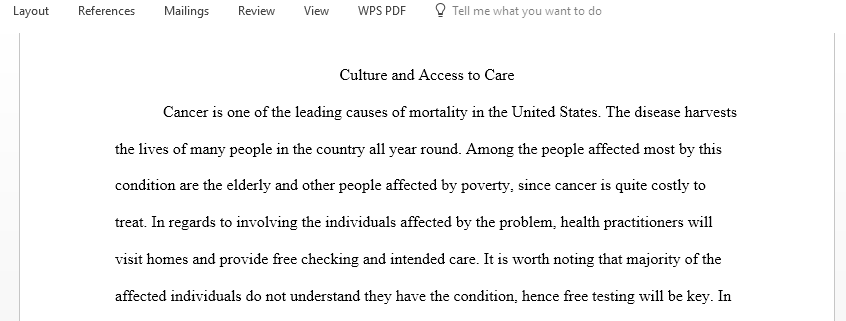Discuss Culture and Access to Health Care
Culture and Access to Health Care—A Framework
Health Promotion for Multicultural Populations
Consider this scenario: (The scenario could have considered any population located within any community, work site, school, or health care program setting.)
Mortality and morbidity from health-related causes have been increasing for the past several years among several population groups living in a large multicultural metropolitan community. The local health jurisdiction, private providers, voluntary agencies, and community members are very concerned and want to reduce the number of deaths and illnesses drastically. Local government officials recognize that increased screening, referral, and treatment programs are critically needed for identifying problems. Limited monies are available for providing health promotion and education programs to selected multicultural target groups. Select a specific target group in a specific geographical area in your county as a frame of reference to work from.
Consider the following questions relevant in a 4 to 5 page Microsoft Word document:
How would you involve those affected by the problem?
How would you identify opportunities for Community-based Participatory Research (CBPR) in health promotion program planning?
How would you assess community capacity as relevant to the program planning effort?
Describe the dynamic relationship between program planning, evaluation, and implementation.
How would you assess the needs of the community or target populations?
How would you diagnose and prioritize health-related concerns (problems and needs) in the community?
How would you assess the specific health promotion and education needs of the target group (i.e., targeted assessment)?
How would you use and apply your knowledge about the predisposing, enabling, and reinforcing factors to assist with your planning team identify the target group and select possible program intervention activities?
What levels of change would be sought in your program?
What specific health promotion and education program goals and objectives would be included in your hierarchy?
What factors would you consider relevant to identifying health promotion program intervention activities that would consider the special needs of the target group, the health problem, and setting?
What levels of evaluation (i.e., impact, outcome, process, and formative) would you use for assessing your previously stated program objectives?
supporting lecture:
Culture and Access to Care—A Framework
There are numerous frameworks/models that can assess, plan, implement, and evaluate Health Promotion and Disease Prevention (HPDP) programs for multicultural population groups. All of these share common elements, including the need to accurately determine what the target population is, what group member’s specific health needs and concerns are, what makes group members unique as a cultural or ethnic group, and what special planning efforts will be needed to deliver culturally competent and sensitive services to them.
The Cultural Assessment Framework (CAF) or model, presented in the text, provides an organizing framework that encourages a more systematic approach to the planning situation, the cultural characteristics of the target group, setting, and health problem.
The framework presents five major levels of assessment:
Culture-specific demographic variable
Culture-specific epidemiological and environmental influences
General and specific cultural characteristics
General and specific health beliefs and practices
Western health care organization and service delivery variables
Each of these levels of assessment identifies a higher level of understanding about the population’s ethnic culture to ensure that culturally appropriate, competent, and sensitive HPDP programs and services are planned for and with group members.
Answer preview for Discuss Culture and Access to Health Care

Access the full answer containing 955 words by clicking the below purchase button.
